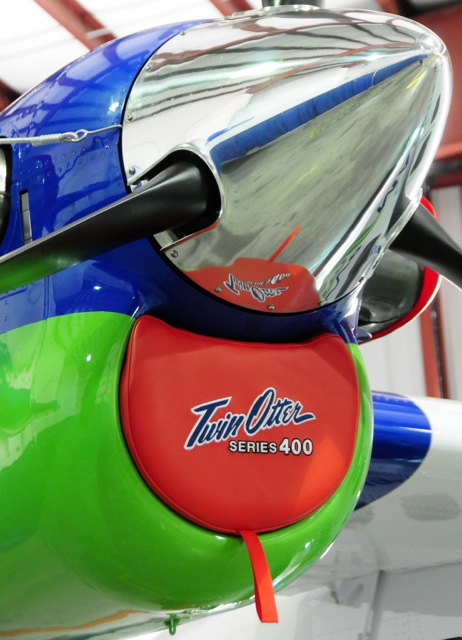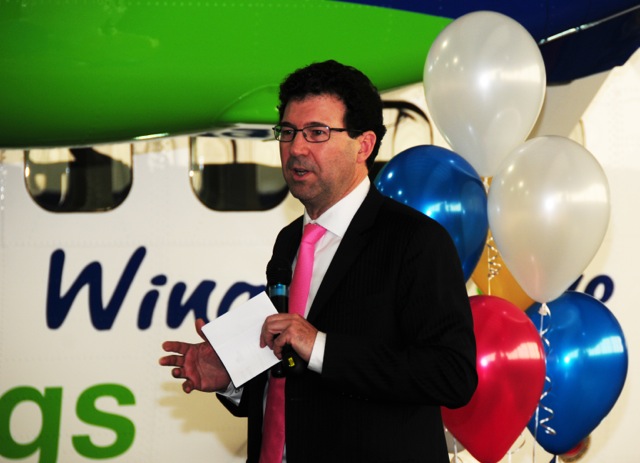
Features
Aircraft manufacturers
Viking celebrates 50th Series 400 Twin Otter
 March 5, 2014, Victoria, B.C. - With a backdrop provided by a gleaming new Series 400 Twin Otter, Viking Air’s president and CEO Dave Curtis addressed a hangar filled with 500 VIPs on Feb. 27 to celebrate the delivery of Viking’s 50th Series 400 Twin Otter.
March 5, 2014, Victoria, B.C. - With a backdrop provided by a gleaming new Series 400 Twin Otter, Viking Air’s president and CEO Dave Curtis addressed a hangar filled with 500 VIPs on Feb. 27 to celebrate the delivery of Viking’s 50th Series 400 Twin Otter.
March 5, 2014 By Paul Dixon
 March 5, 2014, Victoria, B.C. – With a backdrop provided by a gleaming
March 5, 2014, Victoria, B.C. – With a backdrop provided by a gleaming
new Series 400 Twin Otter, Viking Air’s president and CEO Dave Curtis
addressed a hangar filled with 500 VIPs on Feb. 27 to celebrate the
delivery of Viking’s 50th Series 400 Twin Otter.
The VIPs were all Viking employees, the people who built the aircraft and are taking it into new markets around the world. Curtis told the crowd that when it came time to celebrate this milestone, it only made sense to share the moment with the people who made it possible. “These are the people who worked so hard to get us to number 50,” he said. “When I think about the effort people have made to make this such a success, it humbles me.”
It has taken a little over four years to get to number 50 and, with another 50 orders on the books and the potential for hundreds more in the years to come, the future looks bright. The legacy Twin Otter was a true workhorse that has proven itself around the world, in all seasons under all conditions, from the extremes of both operating in the Arctic and Antarctic to tropical jungles, across the Sahara and over the Himalayas.
Today, thanks to the tireless efforts of Curtis and the Viking team, the Twin Otter is moving into uncharted territories. Talking with Wings before the ceremonies started, Curtis talked about new markets for the Twin Otter. “De Haviland didn’t sell a single aircraft in the BRIC (Brazil, Russia, India, China) countries, which is about 40 per cent of the world’s population. There’s probably an opportunity there and we’re working those markets pretty hard,” Curtis said. “We’ve got nine sold into Russia and we’ve got our first deal in China for five. As those countries open up and they become more familiar with the airplane and the product. I think there’s a significant upside.”

|
|
| Photos by Paul Dixon.
|
When asked for his thoughts about doing business in Russia, he offered this advice. “The key for me, if you want to do business in Russia, is to make sure you have reps that you trust implicitly. We have those folks. Also, be prepared to deal with a lot of bureaucracy, but I have to say that it was easier getting our Russian certification that it was getting our FAA certification. The aircraft had never been certified in Russia, so there was no Legacy Twin Otter in the country, so there was no certification. It was smooth. That was the inverse to what I thought.”
Curtis had just returned from Ottawa, where he was promoting Western Canadian aerospace operations as well as trying to sell the Royal Canadian Air Force some new aircraft. “On Tuesday, I was presenting to 30 MPs on aerospace in Western Canada. They are intrigued that we are building aircraft way out West. They still think that aerospace in Canada means Quebec or Ontario. They ask me why we build aircraft in Victoria and I say, it’s because that’s where we are. I also point out that our weather allows us to fly aircraft on a regular basis.”
Putting the company in perspective, Curtis narrated a short slide show of Viking’s history. 1991 saw the delivery of Viking’s first product, the turbo Beaver. The entire Viking workforce of the day was able to line up under the wings of that Beaver, about 35 people. Today, there are almost 700 employees between the Victoria and Calgary operations. If there’s a downside to all of this success, it’s no longer knowing everybody’s first name.